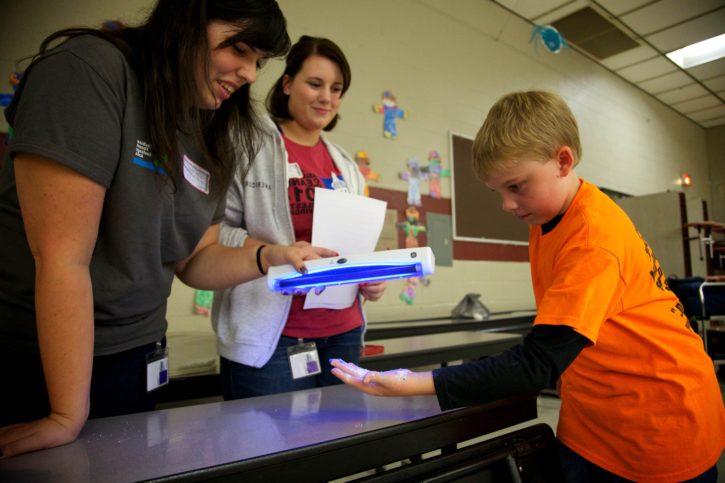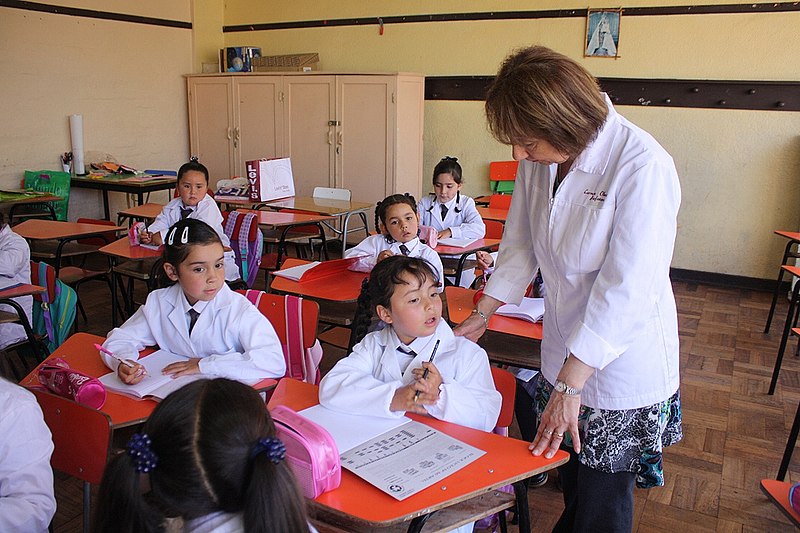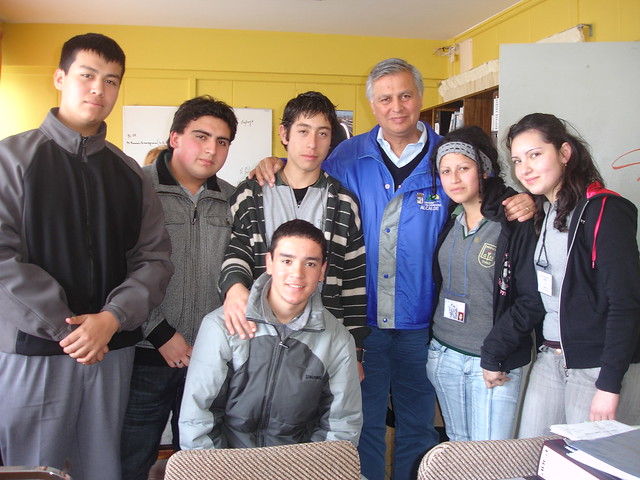12.1: Actividades- ¡Hola! ¿Cómo te llamas?
- Last updated
- Save as PDF
- Page ID
- 115242
(Note: The activities on this page are designed to promote active communication in Spanish. In an online course, your instructor may ask you to complete the activities using a separate tool, such as video/voice recording or web-conferencing software. Even if the activities are not assigned as coursework, they can be used for individual practice and review.)
- Actividades 1.1: ¡Bienvenidos a la clase!
- Actividades 1.2: En el salón de clases y los números
- Actividades 1.3: Género y número de sustantivos
- Actividades 1.4: Artículos indefinidos y definidos / Hay
Actividades 1.1: ¡Bienvenidos a la clase!
A.  ¿Qué saludo usas?
¿Qué saludo usas?
Give the appropriate greeting depending on the time of the day. ¡OJO! This exercise uses the 24 hour time. To convert from 24 hour time to 12 hour, just subtract 12 from the hours 13 and up. (Por ejemplo: 15:37 = 3:37 p.m.)
Modelo:
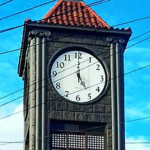
Estudiante: “¡Buenas Tardes!”






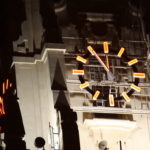
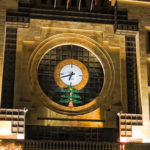
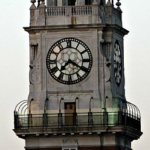
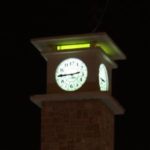
B.  Preguntas
Preguntas
Respond to the following questions.
- ¿Cómo te llamas?
- ¿Qué tal?
- ¿De dónde eres?
- ¿Cómo estás?
C.  Nombres
Nombres
With a partner, spell the following names out loud. One person spells and the other listens and corrects the pronunciation. Be sure to pronounce the tildes (accents).
Modelo: Madison
Estudiante 1: Madison M (eMe) A (a) D (De) I (i) S (eSe) O (o) N (eNe)
Estudiante 2: ¡Muy bien!
Estudiante 1:
- Miguel
- Roberto
- José María
- Ladislao
- Tomás
Estudiante 2:
- Gustavo
- Alejandra
- Maritza
- Xiomara
- Hilda
D. 
Ask five students in the class for their first name (nombre) and last names (apellidos). Be sure to spell out your name.
Modelo:
Estudiante 1: ¿Cómo te llamas?
Estudiante 2: Me llamo Alejandra. ¿Y tú? Estudiante 1: Me llamo Maria Cristina. ¿Cuál es tu apellido y cómo se escribe?
Estudiante 2: Es Escudero. e-ese-ce-u-de-e-ere-o. ¿Y tu apellido?
Estudiante 1: Es Montoya. eme-o-ene-te-o-ye-a
F.  Bingo
Bingo
Circulate among your classmates and try to find people who fit the following descriptions. How would you find out this information? What questions would you ask? (Consider: if you ask “where are you from,” you’ll find out if they’re from nearby or far away. If you ask the classmate for their name, you’ll know if it’s a long or short name. And so on)
E.  Situaciones
Situaciones
| Person A: You are a young person meeting Person B, an older person. You keep using the informal forms, which seems to annoy Person B. |
Person B: You are an older person meeting Person A, a younger person. Person A keeps using the informal forms, which annoys you. |
| Person A: You are two professionals introducing yourselves in a loud room. You can’t seem to hear the name of Person B. Person B has to spell it a few times, since you keep misunderstanding the letters. |
Person B: You are two professionals introducing yourselves in a loud room. Person can’t seem to hear your name. You have to spell it a few times, since Person A keeps misunderstanding the letters. |
| Person A You and Person B are both students. You meet and say hello. You are having a great day, but Person B is having a terrible day. You are extremely cheery. |
Person B You and Person A are both students. You meet and say hello. You are having a terrible day, but Person A seems to be having a great day. Person A’s cheerfulness gets on your nerves, and you leave in disgust. |
| Person A You are a student. You want to know if Person B is Professor Rivera. Person B is indeed Professor Rivera, but seems very busy. When Professor Rivera says “see you tomorrow!” you are confused, since there’s no class tomorrow. |
Person B You are Professor Rivera. Person A, a student, wants to know if you are Professor Rivera. You’re too busy to talk right now, so you listen distractedly, then say “see you tomorrow!” and rush off. |
| Person A At the office: You meet a new co-worker, Partner B. You’re pretty sure that Partner B is “Lobo”, an old friend from college. You greet Lobo enthusiastically. |
Person B At the office: You meet a new co-worker, Partner A. Partner A seems convinced that you’re “Lobo,” an old friend of theirs. You are definitely not “Lobo.” |
Actividades 1.2: En el salón de clases y los números
A.  Números 0-31
Números 0-31
Write the numbers your instructor will read out loud. Make sure to write them in letters as well as in numerical form.
- _____________________
- _____________________
- _____________________
- _____________________
- _____________________
- _____________________
- _____________________
- _____________________
B.  ¿Cómo se escribe?
¿Cómo se escribe?
Spell the vocabulary of the classroom out loud (with or without a partner).
Modelo:
Estudiante 1: ¿Cómo se escribe mochila?
Estudiante 2: Eme – o – ce – hache – i – ele – a
C.  Preguntas con números
Preguntas con números
Answer the following questions with the numbers you have learned.
Modelo: ¿Cuántos años tienes? (How old are you?)
Estudiante 1: ¿Cuántos años tienes?
Estudiante 2: Veinte ¿Y tú?
Estudiante 1: Veintidós
- ¿Cuántos años tienes?
- ¿Cuántos libros tienes?
- ¿Cuántos lápices tienes?
- ¿Cuántos papeles tienes?
- ¿Cuántos teléfonos tienes?
- ¿Cuántos cuadernos tienes?
- ¿Cuántos relojes tienes?
- ¿Cuántos profesores tienes?
- ¿Cuántas clases tienes?
- ¿Cuántas carpetas tienes?
Actividades 1.3: Género y número de sustantivos
A.  Singular a plural.
Singular a plural.
Change the nouns from singular to plural. Notice if the noun is masculine or feminine.
Modelo: el cuaderno = los cuadernos; la luz = las luces
- La universidad …… plural: ___________________
- El papel …………….. plural: ___________________
- La bandera ………… plural: ___________________
- El mapa …………….. plural: ___________________
- La chica …………….. plural: ___________________
- El pupitre …………… plural: ___________________
- La mochila …………. plural: ___________________
- La pared……………… plural: ___________________
- La mano …………….. plural: ___________________
- El chico …………….. plural: ___________________
Actividades 1.4: Artículos indefinidos y definidos / Hay
A.  ¿Hay o no hay?
¿Hay o no hay?
Look at the photo and say whether the item(s) mentioned is/are there.
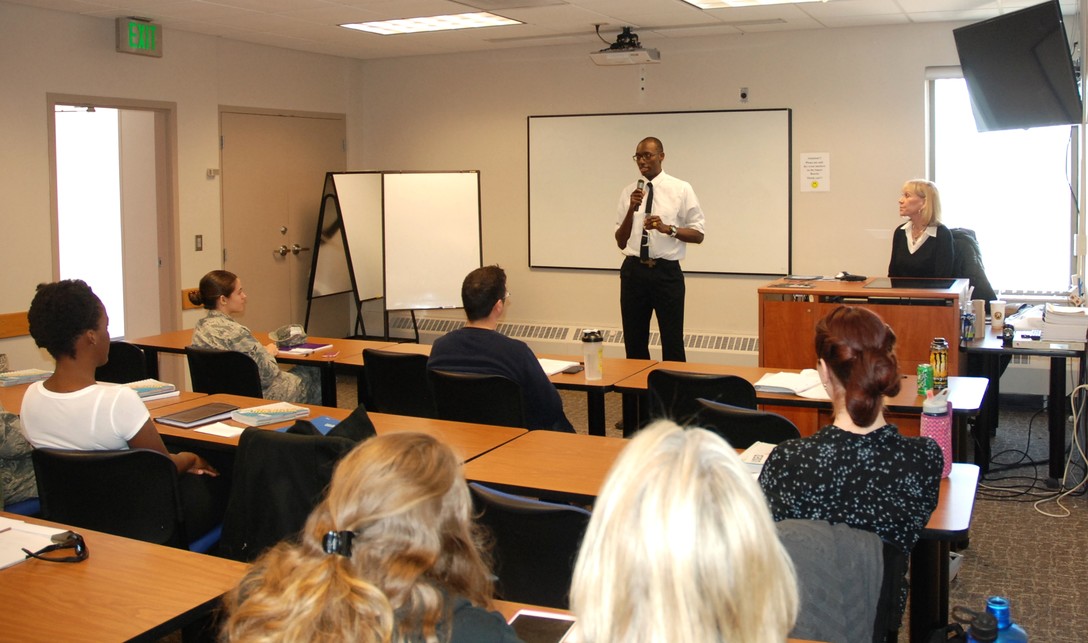
Modelo: pizarras
Estudiante 1: ¿Hay pizarras?
Estudiante 2: Sí, hay tres pizarras. / Sí, hay pizarras. / No, no hay pizarras.
B.  ¿Qué hay?
¿Qué hay?
Take turns with a partner asking and answering the following questions about what is in your classroom or the space where you work.
Modelo:¿Hay mesas?
Estudiante 1: ¿Hay mesas?
Estudiante 2: Sí, hay una mesa / Sí, hay mesas / No, no hay mesas.
- ¿Hay sillas?
- ¿Hay computadoras?
- ¿Hay puertas?
- ¿Hay pupitres?
- ¿Hay ventanas?
- ¿Hay mapas?
- ¿Hay banderas?
- ¿Hay mesas?
C.1.  ¿Qué hay en la clase?
¿Qué hay en la clase?
Take turns with a partner asking and answering questions about what is in the classroom below.
Modelo:
- Estudiante 2: ¿Hay sillas?
- Estudiante 1: Sí, hay sillas
- Estudiante 2: ¿Cuántas sillas hay?
- Estudiante 1: Hay veinticinco sillas.
- Estudiante 1
-
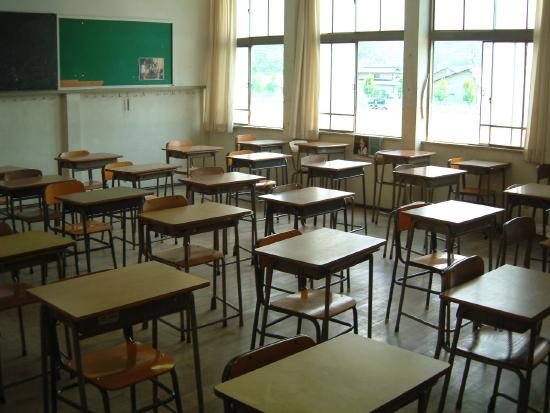
- Estudiante 2
-
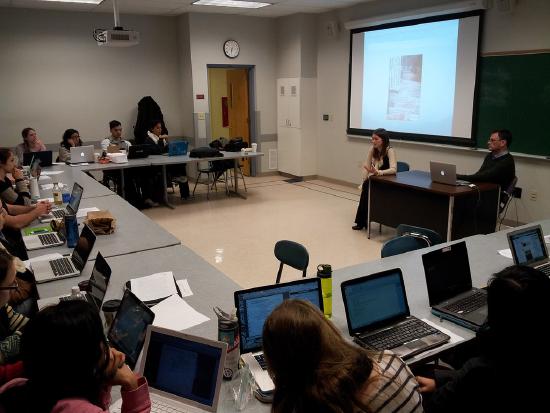
C.2.  ¿Qué hay en tu oficina?
¿Qué hay en tu oficina?
You and your partner are now teachers and below is a picture of your office and your partner’s office. Take turns asking each other questions about the other person’s office.
Modelo:
- Estudiante 1: ¿Hay mapas?
- Estudiante 2: Sí, hay mapas / No, no hay mapas.
- Estudiante 1
-
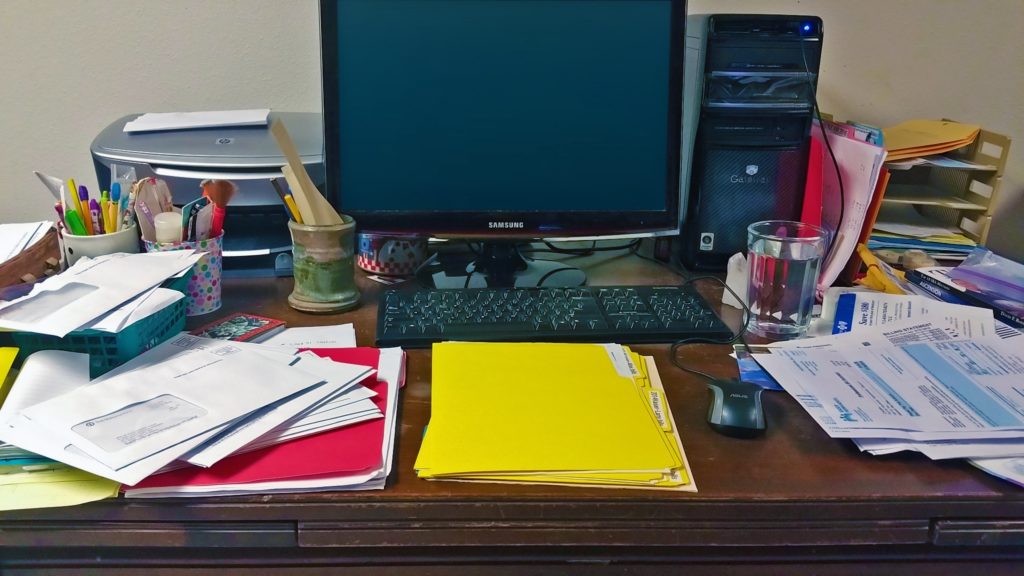
- Estudiante 2
-

D.  ¿Cuántas personas?
¿Cuántas personas?
Say how many of the following kinds of people you see in the photographs.
- profesor
- maestro
- hombre (men) o mujer (women)
- estudiante
- niño (child)
- ¿y en tu propia (your own) clase?
Modelo:
Estudiante 1: ¿Cuántos estudiantes hay en la foto 1?
Estudiante 2: Hay un estudiante.
| 1.
|
2.
|
| 3.
|
4.

Tu propia clase (Your own class)
|
E.  ¿Qué necesitamos?
¿Qué necesitamos?
Paso 1: It’s a month before school starts and you and your partner are co-teachers in an elementary school. You must compare your inventory of what you both have (¿Hay suficientes _______ (Are there enough)?) and decide how many more you need to buy, given that there will be 25 students in the class.
Modelo: Pupitre – 26
Estudiante 1: ¿Hay suficientes pupitres?
Estudiante 2: Si, hay veintiséis pupitres. / No, necesitamos cinco más.

Inventario de estudiante 1:
- Papel – 20
- Libro – 21
- Cuaderno – 9
- Lápiz – 13
- Bolígrafo – 2
- Diccionario inglés/inglés – 1
- Mapa de México – 0
Inventario de Estudiante 2:
- Computadora – 0
- Calculadora – 0
- Pizarra – 2
- Tiza – 0
- Basura – 0
- Mapa del mundo – 1
- Diccionario inglés/español – 0
Paso 2: Inventario de nuestra (our) clase. Now do your own inventory of your own classroom; compare yours with a classmate’s: whose list is more complete? Did you count up the same number of each item? ¡OJO! Be sure to spell out the numbers.
F.  Conferencia de biología
Conferencia de biología
You and your partner are planning an international biology conference. It’s time to figure out where all the presentations will be held. Each of you has corresponded with half of the presenters, and has been given half of the information about rooms at the conference center.
Instructions:
- Fill in the “Notas” table by checking off the items each of your presenters needs, as articulated in their email to you (in your inbox: “Recibidos”). Even if you don’t understand all the words in the email, try to figure out what the presenter is asking for.
- Tell your partner which equipment your first presenter needs, as well as the number of chairs the room should have. Your partner will check their list of available rooms and decide which one would be best for that presenter.
- Now your partner explains what their first presenter needs. Check your list of available rooms (“Tabla de capacidad”) to find the right room, and write the presenter’s name in the column to the right. They may need to spell out the name!
- Repeat for all presenters.
See below your half of the information (or download the pdf).
Estudiante 1: Recibidos (inbox)
 |
Dra. Alma Mar maralma@unam.mx para mí ▾ ¡Gracias por su mensaje! El título de mi presentación es “A las plantas les gusta la música heavy metal?” Necesito una computadora con altavoces (speakers) para reproducir ejemplos musicales. La audiencia será muy pequeña (un máximo de seis personas). |
 |
Dra. Denisse Núñez dnunez@una.py para mí ▾ ¡Gracias! Me siento honrada por asistir a la reunión. Mi presentación es sobre la calculación de la probabilidad de la vida inteligente en nuestro sistema solar. Solamente necesito una pizarra para mis ecuaciones. Me gustaría una mesa para impulsar una discusión. Espero 10-12 personas en la audiencia. |
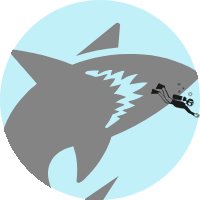 |
Julia Duckworth-Clarke mega@uq.edu.au para mí ▾ Presento el proyecto MEGA que cría tiburones gigantes para proteger los arrecifes de coral de los buzos (from scuba divers). Espero 9-12 personas en la audiencia. Necesito un mapa del mundo. Necesito un salón sin ventanas. No fotos por favor. |
 |
Chet Frank chet@ecowow.biz para mí ▾ Mi presentación (la que presento al Foro Económico Mundial en Davos) se llama “Yes, We Can Buy Our Way Out of Climate Change!” (“¡Sí, podemos comprar una solución al cambio climático!”) Necesito un micrófono y un proyector. Tengo mi propia computadora. Puede esperar un grupo grande (30 y más) ya que soy orador popular. |
 |
Prof. Dr. Dr. Helmut von Torkle torkle@uni-freiburg.de para mí ▾ Mi presentación se llama “Courtship Rituals of the Sea Slug” (“Rituales de cortejo de la babosa de mar”). Tengo una presentación de Powerpoint con muchas fotos y tablas fascinantes (necesito un proyector). Mi presentación es muy difícil así que espero una audiencia muy pequeña (3-5 personas). Además normalmente mis presentaciones llevan mucho tiempo así que necesito un reloj para mantenerme puntual para no pasarme de tiempo. |
Estudiante 1: Notas
 |
 |
 |
 |
 |
 |
¿Cuántas sillas? | |
|
Alma Mar |
✓ | 6 | |||||
|
Denisse Núñez |
|||||||
|
Julia Duckworth-Clarke |
|||||||
|
Chet Frank |
|||||||
|
Helmut von Torkle |
Modelo: Alma Mar necesita (needs) una computadora y sillas para seis personas.
Estudiante 1: Tabla de capacidad
| Sala de reuniones |  |
 |
 |
 |
 |
 |
 |
Disposición de la sala | ¿Quién presenta aquí? |
| Sala 11 | ✘ no | ✘ no | ✘ no | ✓ sí | ✘ no | ✓ sí | ✘ no |  |
|
| Sala 12 | ✘ no | ✓ sí | ✘ no | ✘ no | ✓ sí | ✘ no | ✘ no |  |
|
| Sala 14 | ✘ no | ✓ sí | ✓ sí | ✘ no | ✓ sí | ✘ no | ✓ sí |  |
|
| Sala 16 | ✓ sí | ✓ sí | ✘ no | ✘ no | ✓ sí | ✘ no | ✓ sí |  |
|
| Sala 18 | ✓ sí | ✓ sí | ✘ no | ✓ sí | ✓ sí | ✓ sí | ✓ sí | 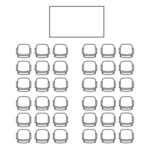 |
Modelo: En la sala 11 hay una computadora y un proyector. Hay doce sillas.
Estudiante 2: Recibidos (inbox)
 |
Dr. Noah de la Rosa noahrosa@uasd.edu.do para mí ▾ Presento mi trabajo sobre los hámsters siberianos en peligro de extinción. Necesito una computadora y un proyector. Espero 10-12 personas. |
 |
Dr. Fen Guo guo@tsinghua.edu.cn para mí ▾ ¡Gracias por su correo electrónico! Mi presentación se llama “Enzymes and Algorithms: Building a Better Cheese” (“Enzimas y Algoritmos: Crear un Queso Mejor”). Me gustaría una mesa bastante grande para 12 personas. También necesitamos una ventana que se puede abrir. |
 |
Dr. Joaquín Pereira jp@ort.edu.uy para mí ▾ Me alegra mucho poder asistir a la reunión. Mi presentación es sobre las fuentes energéticas basadas en plancton. El grupo será grande (más de 30 personas). Necesito un micrófono y una pizarra blanca. |
 |
Prof. Nadja Petrov nadjap@nsu.ru para mí ▾ Me siento honrada por estar a esta reunión. El título de mi presentación es: “Can Cats Tell Time?” (“Pueden los Gatos Decir la Hora?)” Espero una audiencia de 4-6 personas. Necesito una pizarra y un reloj para una demostración. Tengo mi propio puntero láser. |
 |
Dra. Violeta Pérez-Huerta perezhuerta@uam.es para mí ▾ ¡Gracias por invitarme a la reunión! Mi clase se llama “Arañas Súper Genéticamente Modificadas: Son Monas (cute), ¿Pero Son Inocuas (safe)?” Necesito un salón sin ventanas. La audiencia será pequeña (menos de 6). |
Estudiante 2: Notas
 |
 |
 |
 |
 |
 |
¿Cuántas sillas? | |
|
Noah de la Rosa |
✓ | ✓ | 12 | ||||
|
Fen Guo |
|||||||
|
Joaquín Pereira |
|||||||
|
Nadja Petrov |
|||||||
|
Violeta Pérez-Huerta |
Modelo: Noah de la Rosa necesita (needs) una computadora, un proyector, y sillas para doce personas.
Estudiante 2: Tabla de capacidad
| Sala de reuniones |  |
 |
 |
 |
 |
 |
 |
Disposición de la sala | ¿Quién presenta aquí? |
| Sala 21 | ✘ no | ✓ sí | ✘ no | ✘ no | ✓ sí | ✓ sí | ✓ sí |  |
|
| Sala 22 | ✓ sí | ✘ no | ✘ no | ✘ no | ✓ sí | ✘ no | ✘ no |  |
|
| Sala 25 | ✘ no | ✓ sí | ✘ no | ✓ sí | ✓ sí | ✘ no | ✓ sí |  |
|
| Sala 26 | ✘ no | ✘ no | ✓ sí | ✘ no | ✓ sí | ✘ no | ✘ no |  |
|
| Sala 27 | ✓ sí | ✓ sí | ✘ no | ✓ sí | ✘ no | ✓ sí | ✓ sí |  |
Modelo: En la sala 21 hay un proyector y un reloj. Hay seis sillas.
Contributors and Attributions
- Clock Tower (Torre del Rellotge) (15:37). Authored by: Arjan Richter. Located at: https://www.flickr.com/photos/arjanrichter/26055751432. License: CC BY: Attribution
- Reloj, Chiapa de Corzo (08:05). Authored by: Bluemardigrass. Located at: https://es.Wikipedia.org/wiki/Archivo:Reloj,_Chiapa_de_Corzo.JPG. License: CC BY-SA: Attribution-ShareAlike
- Reloj de la estructura de la Estacion Central (12:35). Authored by: Cuidro. Located at: https://commons.wikimedia.org/wiki/File:Reloj_de_la_estructura_de_la_Estaci%C3%B3n_Central.JPG. License: CC BY-SA: Attribution-ShareAlike
- Reloj de Telefonica (23:55). Authored by: Angel Abril Ruiz. Located at: https://www.flickr.com/photos/aabrilru/3711397890/in/photolist-6DXThN-aA65Zq-aA1ZSx-cXug69-aA21Dg-bQQFyn-aA4Fvj-aA65Rh-cXunK7-aA4Fz1-cXumRh-6B7aLK-aA4Euj-aA3qh4-aA3poa-aA4Ew3-cXuo1h-cXuiJJ-aA3pQK-cXufHQ-aA21aR-7ZcWKi-7orKXy-6avQ6X-aA3pC6-aA4XGo-aA3q3V-aA3pia-aA3pk4-aA2hxp-bQQFu8-6P9FSd-aA21yV-cXukNj-aA4Fsd-aA2hFx-aA21gp-aA4Eyy-cXueLu-aA3qj4-aA2hCz-6MaTSG-aA667N-aA4XB1-aA2hJD-cXupEq-7RKRPi-cXueid-aA4Ffh-aA4EB5. License: CC BY: Attribution
- Ayuntamiento de Albacete (18:42). Authored by: Gabriel Villena. Located at: https://www.flickr.com/photos/gvillena/3132349447/in/photolist-5LN7mX-bZ4iLS-cXup6h-aA4EHG-aA3pur-6DXThN-aA65Zq-aA1ZSx-cXug69-aA21Dg-bQQFyn-aA4Fvj-aA65Rh-cXunK7-aA4Fz1-cXumRh-6B7aLK-aA4Euj-aA3qh4-aA3poa-aA4Ew3-cXuo1h-cXuiJJ-aA3pQK-cXufHQ-aA21aR-7ZcWKi-7orKXy-6avQ6X-aA3pC6-aA4XGo-aA3q3V-aA3pia-aA3pk4-aA2hxp-bQQFu8-6P9FSd-aA21yV-cXukNj-aA4Fsd-aA2hFx-aA21gp-aA4Eyy-cXueLu-aA3qj4-aA2hCz-6MaTSG-aA667N-aA4XB1-aA2hJD. License: CC BY: Attribution
- Plaza Prat y su Torre del Reloj de noche (00:10). Authored by: Freddy Alexander Bugueuno Tolmo. Located at: https://commons.wikimedia.org/wiki/File:Plaza_Prat_y_su_Torre_del_Reloj_de_noche..jpg. License: CC BY-SA: Attribution-ShareAlike
- Reloj de la Torre Latinoamericana (15:05). Authored by: ProtoplasmaKid. Located at: https://commons.wikimedia.org/wiki/File:Reloj_de_la_Torre_Latinoamericana.jpg. License: CC BY-SA: Attribution-ShareAlike
- Torre y reloj con papamoscas (06:43). Authored by: Inma Gasteiz. Located at: https://commons.wikimedia.org/wiki/File:Torre_y_reloj_con_%22papamoscas%22.jpg. License: CC BY-SA: Attribution-ShareAlike
- El Reloj del Centenario de Bustos (17:00). Authored by: KurteousDerhen. Located at: https://commons.wikimedia.org/wiki/File:El_Reloj_del_Centenario_de_Bustos.jpg. License: CC BY-SA: Attribution-ShareAlike
- Reloj Publico de Noche (02:45). Authored by: Lobo2y. Located at: https://commons.wikimedia.org/wiki/File:Reloj_Publico_de_Noche.jpg. License: CC BY-SA: Attribution-ShareAlike
- Reloj de la Torre Monumental (07:20). Authored by: Emiliorisoli. Located at: https://commons.wikimedia.org/wiki/File:Reloj_de_la_Torre_Monumental.JPG. License: CC BY-SA: Attribution-ShareAlike
- Classroom. Authored by: frwl. Located at: https://commons.wikimedia.org/wiki/File:Japanese_high_school_classroom.jpg. License: CC BY: Attribution
- The Modern College Classroom. Authored by: Todd Van Hoosear. Located at: https://www.flickr.com/photos/vanhoosear/8514486716. License: CC BY-SA: Attribution-ShareAlike
- ultraviolet light. Authored by: Hagerty Ryan, USFWS. Located at: https://pixnio.com/es/gente/profesor-estudiantes-ultravioleta-brillo-la-luz-el-juego. License: CC0: No Rights Reserved
- Normal regreso a clases de estudiantes choreros. Provided by: Municipalidad de Talcahuano. Located at: https://es.Wikipedia.org/wiki/Archivo:Normal_regreso_a_clases_de_estudiantes_choreros.jpg. License: CC BY-SA: Attribution-ShareAlike
- Liceo Tecnico C-25 de Talcahuano. Provided by: Municipalidad de Talcahuano. Located at: https://www.flickr.com/photos/talcahuanofotos/4905262144. License: Public Domain: No Known Copyright
- The stationery cupboards at the WMUK office.. Authored by: Mike Peel. Located at: https://commons.wikimedia.org/wiki/File:WMUK_office_-_stationery_cupboard_March_2012.jpg. License: CC BY-SA: Attribution-ShareAlike
- Back of head. Authored by: Robin Higgins. Located at: https://pixabay.com/photos/behind-back-head-back-of-head-3082826/. License: Other. License Terms: Pixabay License
- Office store interior. Authored by: Dtp83. Located at: https://commons.wikimedia.org/wiki/File:Typical_Office_1_store_interior.jpg. License: CC BY-SA: Attribution-ShareAlike
- Simone Simons en el festival Rockharz, 2014. Authored by: S. Bollmann. Located at: https://es.Wikipedia.org/wiki/Simone_Simons#/media/Archivo:Epica_Rockharz_2015_19.jpg. License: CC BY-SA: Attribution-ShareAlike
- Icons. Authored by: Noun Project.. Located at: http://thenounproject.com. License: CC BY: Attribution. License Terms: NounPro license
- Nikolas Badminton Futurist Speaker. Authored by: Nikolas Badminton. Located at: https://commons.wikimedia.org/wiki/File:Nikolas_Badminton_Futurist_Speaker_on_Stage_in_Vancouver.jpg. License: CC BY-SA: Attribution-ShareAlike
- Birger Kollmeier. Authored by: Ju00fc. Located at: https://commons.wikimedia.org/wiki/File:Birger_Kollmeier_Oldenburg.jpg. License: CC0: No Rights Reserved
- A Syrian hamster filling his cheek pouches with Dandelion leaves. . Authored by: Peter Maas. Located at: https://commons.wikimedia.org/wiki/File:Syrian_hamster_filling_his_cheek_pouches_with_Dandelion_leaves.JPG. License: CC BY: Attribution
- Coulommiers lait cru. Authored by: Myrabella. Located at: https://commons.wikimedia.org/wiki/File:Coulommiers_lait_cru.jpg. License: CC BY-SA: Attribution-ShareAlike
- Woman with Cat. Located at: https://www.maxpixel.net/Love-Girl-Pet-Woman-Cat-Animals-Lady-People-2570587. License: CC0: No Rights Reserved
- Female Sydney funnel-web spider in a warning posture. Authored by: Tirin. Located at: https://en.Wikipedia.org/wiki/Sydney_funnel-web_spider#/media/File:Atrax_robustus.jpg. License: CC BY-SA: Attribution-ShareAlike
- immigration card for Dolores Rivas Cherifu00a0. Authored by: u00c1rea de Digitalizaciu00f3n. Direcciu00f3n de Publicaciones y Difusiu00f3n.. Located at: https://es.Wikipedia.org/wiki/Archivo:Dolores_Rivas_Cherif_-_Registro_Nacional_de_Extranjeros_en_M%C3%A9xico_-_1941.jpg. License: CC BY-SA: Attribution-ShareAlike
- Bill Clintonu2019s international student ID. Authored by: Thomas R Machnitzki. Located at: https://commons.wikimedia.org/wiki/File:Clinton_exhibit_Presidential_Library_Little_Rock_AR_2013-06-07_019.jpg. License: CC BY-SA: Attribution-ShareAlike
- Speaker Nancy Pelosi, Marc Anthony, Jennifer Lopez, and Nydia Velu00e1zquez. Authored by: Nancy Pelosi. Located at: https://www.flickr.com/photos/speakerpelosi/3926753297/. License: CC BY: Attribution
- Shakira at the Rock in Rio concert in 2008.. Located at: https://en.m.Wikipedia.org/wiki/File:Shakira_Rio_06.jpg. License: CC BY: Attribution
- Carlos Vives. Located at: https://es.Wikipedia.org/wiki/Archivo:CarlosVives.jpg. License: CC BY: Attribution
- Romeo Santos y Juan Luis Guerra. Authored by: Alex Cancino. Located at: https://commons.wikimedia.org/wiki/File:Romeo_Santos_y_Juan_Luis_Guerra.jpg. License: CC BY-SA: Attribution-ShareAlike
- Ricky Martin at the National Puerto Rican Day Parade. Authored by: Brian. Located at: https://commons.wikimedia.org/wiki/Ricky_Mart%C3%ADn#/media/File:Ricky_Martin_at_the_National_Puerto_Rican_Day_Parade.jpg. License: CC BY-SA: Attribution-ShareAlike
- Office coloring image (adapted ). Authored by: BSGStudio. Located at: https://all-free-download.com/free-vector/download/working-place-vector-illustration-with-colored-style_6824781.html. License: CC BY: Attribution
- Desk coloring image (adapted). Authored by: peecheey. Located at: https://all-free-download.com/free-vector/download/working-area_6813254.html. License: CC BY: Attribution
- Desk coloring images (adapted). Authored by: peecheey. Located at: https://all-free-download.com/free-vector/download/workspace-illustration_6813239.html. License: CC BY: Attribution
- Horoscopes. Authored by: OpenClipart-Vectors. Located at: https://pixabay.com/it/vectors/animali-oroscopo-oroscopo-cinese-160975/. License: Other. License Terms: Pixabay license (https://pixabay.com/pt/service/license/)
- Fanny Lu, Farina - Te Quedaste Solo Album cover. Located at: http://www.fannylu.com/. License: All Rights Reserved. License Terms: Fair Use
- Public speaking class. Authored by: Dave Smith. Provided by: U.S. Air Force. Located at: https://www.afspc.af.mil/News/Article-Display/Article/731080/getting-help-getting-ahead-with-education/. License: Public Domain: No Known Copyright
- Messy Desk. Located at: https://www.publicdomainpictures.net/ro/view-image.php?image=183434&picture=messy-desk-nu-exist-mesaje. License: Public Domain: No Known Copyright
- chair coffee computer. Authored by: Pixabay. Located at: https://www.pexels.com/photo/business-chair-coffee-computer-265072/. License: Public Domain: No Known Copyright
- civil aeronautics card for Onita Thorley. Provided by: SDASM Archives. Located at: https://www.flickr.com/photos/sdasmarchives/8673042164. License: Public Domain: No Known Copyright
- Guitar hero. Authored by: Cpl. Andrew S. Avitt. Located at: https://www.29palms.marines.mil/News/Photos/igphoto/160014/. License: Public Domain: No Known Copyright
- Unidad 1 Actividades. Authored by: SUNY Oneonta with Lumen Learning. Provided by: SUNY Oneonta. License: CC BY: Attribution
- Activities. Authored by: Diamond Wilson with Lumen Learning. License: CC BY: Attribution



